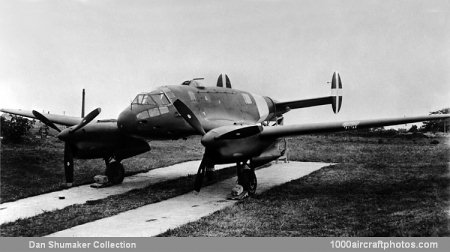04/30/2011. The Ca.331 Raffica (Squall) designed by Chief Engineer Cesare Pallavicino of the Compania Aeronautica Bergamasca at Bergamo (also referred to as Caproni Bergamaschi) stemmed from a series of light twin-engined aircraft initiated by the Borea feederliner of 1935.
The Raffica differed from its predecessors in supplanting the steel tube structure with ply and fabric covering with an all-metal stressed-skin structure – the first of its kind produced by the Bergamasca plant – and the first of two prototypes, serialed MM427 and MM428, was flown on August 31, 1940, as a Ca.331 OA (Osservazione Area, literally Area Observation) light reconnaissance-bomber.
Possessing exceptionally clean lines, a sturdy structure and good handling qualities, the first prototype Ca.331 OA attained a maximum speed of 299 mph (481 kmh) at 16,732 ft (5,100 m) during official trials at Guidonia on the power of two Isotta-Fraschini Delta R.C.40 twelve-cylinder air-cooled inverted V-engines rated at 770 hp at 13,123 ft (4,000 m). The prototype was also tested by the Luftwaffe at Rechlin, but owing to Italy's critical shortage of light alloys, no production order for the light bomber was placed on behalf of the Regia Aeronautica.
By the autumn of 1942, however, the increasing menace of heavy Allied air attacks on Italian industry resulted in the decision to adapt the Raffica for the night-fighting role, and an order was placed for one thousand machines as the Ca.331b. The Ca.331 prototypes were converted to the Ca.331b CN (Caccia Notturno, Night Fighter) for which a new nose section was designed, total forward-firing armament being six 0.50 in (12.7 mm) SAFAT machine guns. A hand-operated 0.50 in (12.7 mm) SAFAT machine gun was fitted in each of the dorsal and ventral positions.
By August 1943 one of the prototypes had been tested with a forward-firing armament of two 0.50 in (12.7 mm) machine guns and 0.787 in (20 mm) Mauser cannon, the other having a ventral tray housing six 0.787 in (20 mm) Ikaria cannon which were smaller and lighter than the Mauser cannon.
In addition to night fighting, the Ca 331b could be used for assault and torpedo-dropping roles. A jettisonable fuel tank or a 220 lb (100 kg) bomb could be carried under each wing, and a small bomb bay was provided which could accommodate 2,200 lb (1,000 kg) of small bombs or a 132 gal (500 l) auxiliary fuel tank. Armor protection (0.24 and 0.31 in, 6 mm and 8 mm) was provided for the three crew members.
By September 8,1943, when Italy capitulated, preparations for quantity production had reached an advanced stage. The engine nacelles, landing gear and rear fuselage were being manufactured at Ponte San Pietro; the wings were being manufactured by Reggiane at Reggio Emilia; the tail assembly was being produced by the Caproni factory at Trento, and various other plants were supplying components.
Proposals had been made for a tank-busting variant with a 1.46 in (37 mm) cannon in a ventral fairing, and consideration was given to the installation of the 1,475 hp Fiat R.A.1050 R.C.58 Tifone (Typhoon) (license-built Daimler Benz DB 605A-1) liquid-cooled engine in place of the air-cooled Delta IV. With the Armistice the two Ca 331b Raffica prototypes were seized by the Germans and, eventually dismantled and scrapped. Tooling for the production model was never completed.
